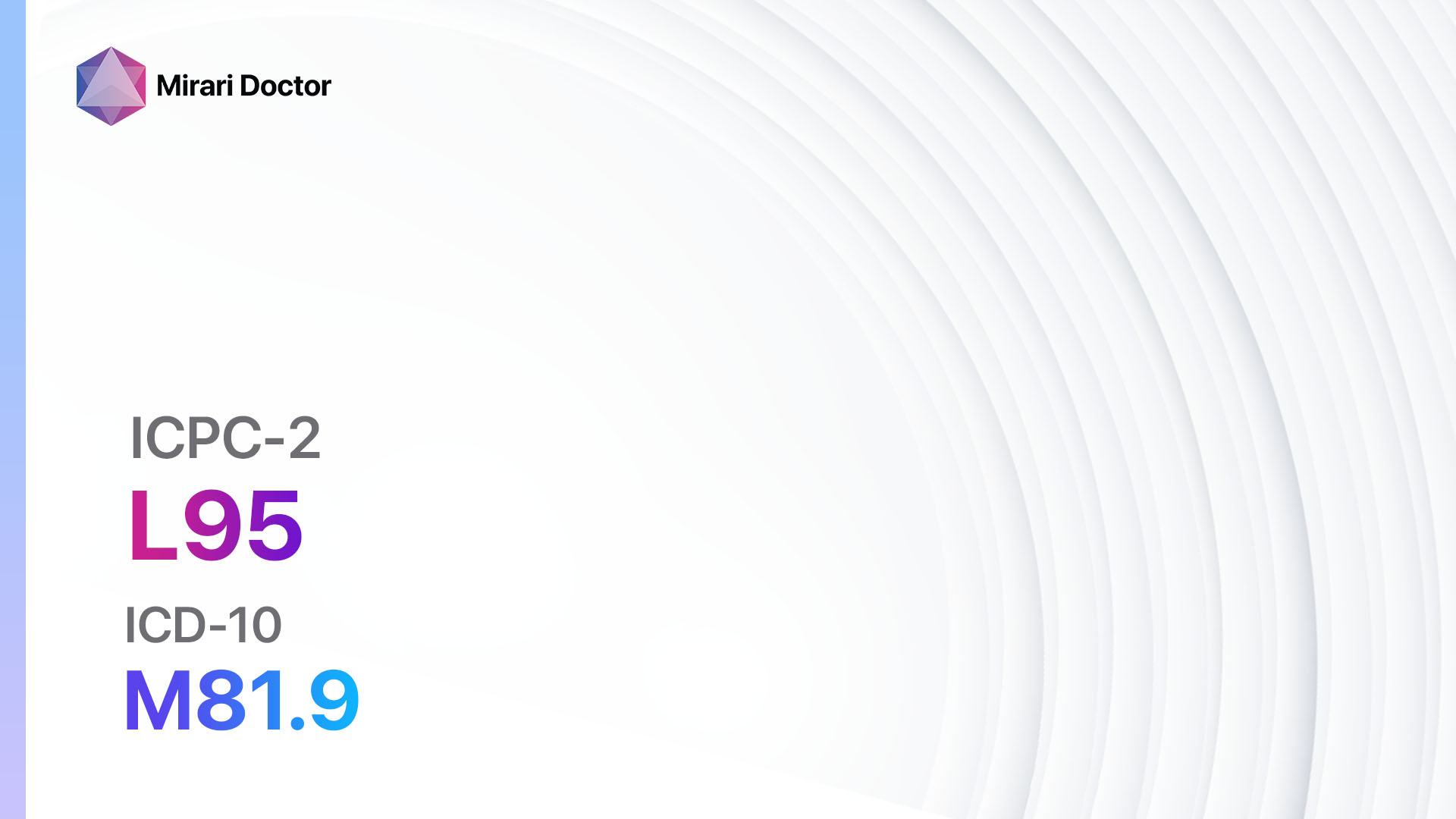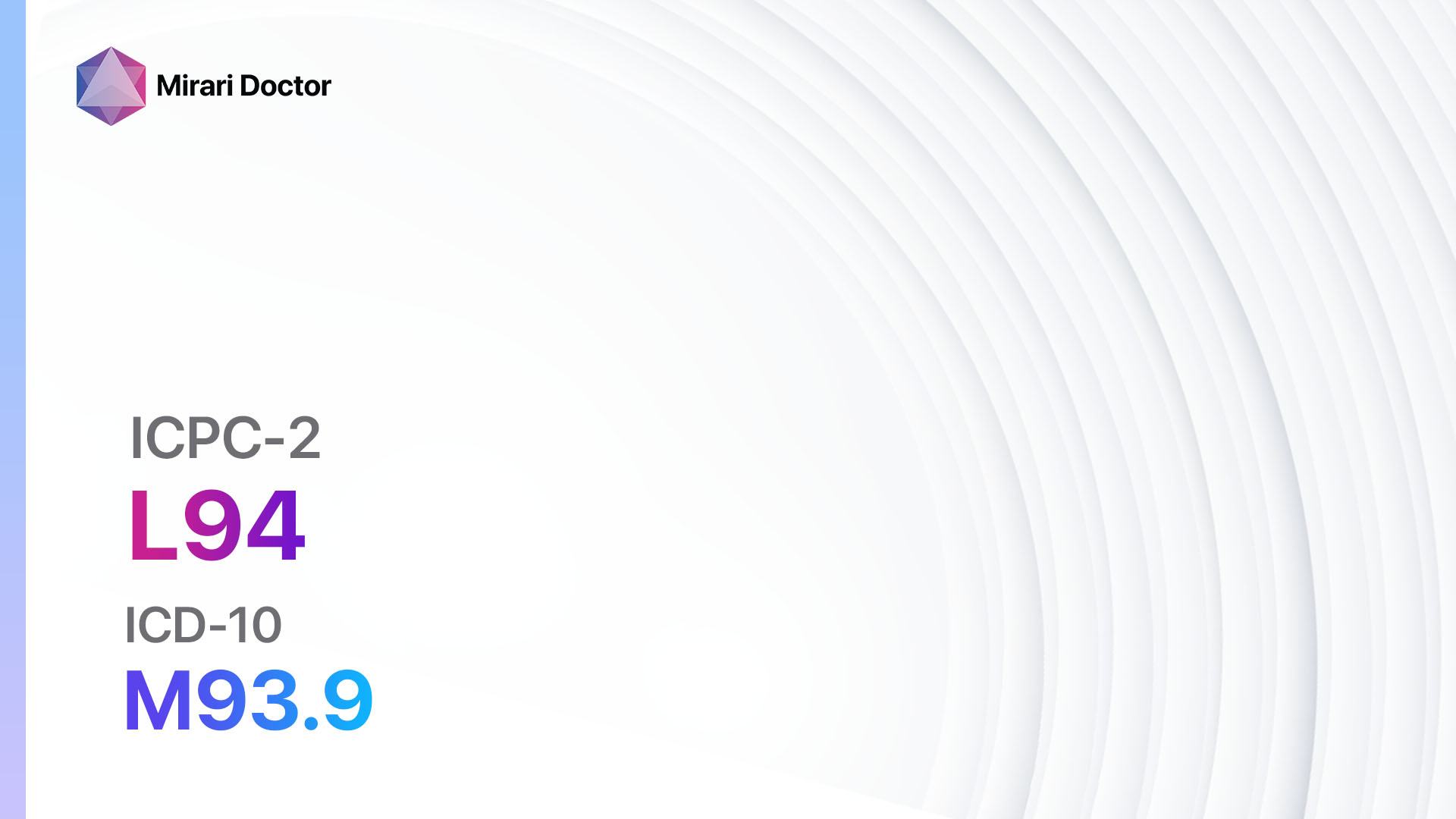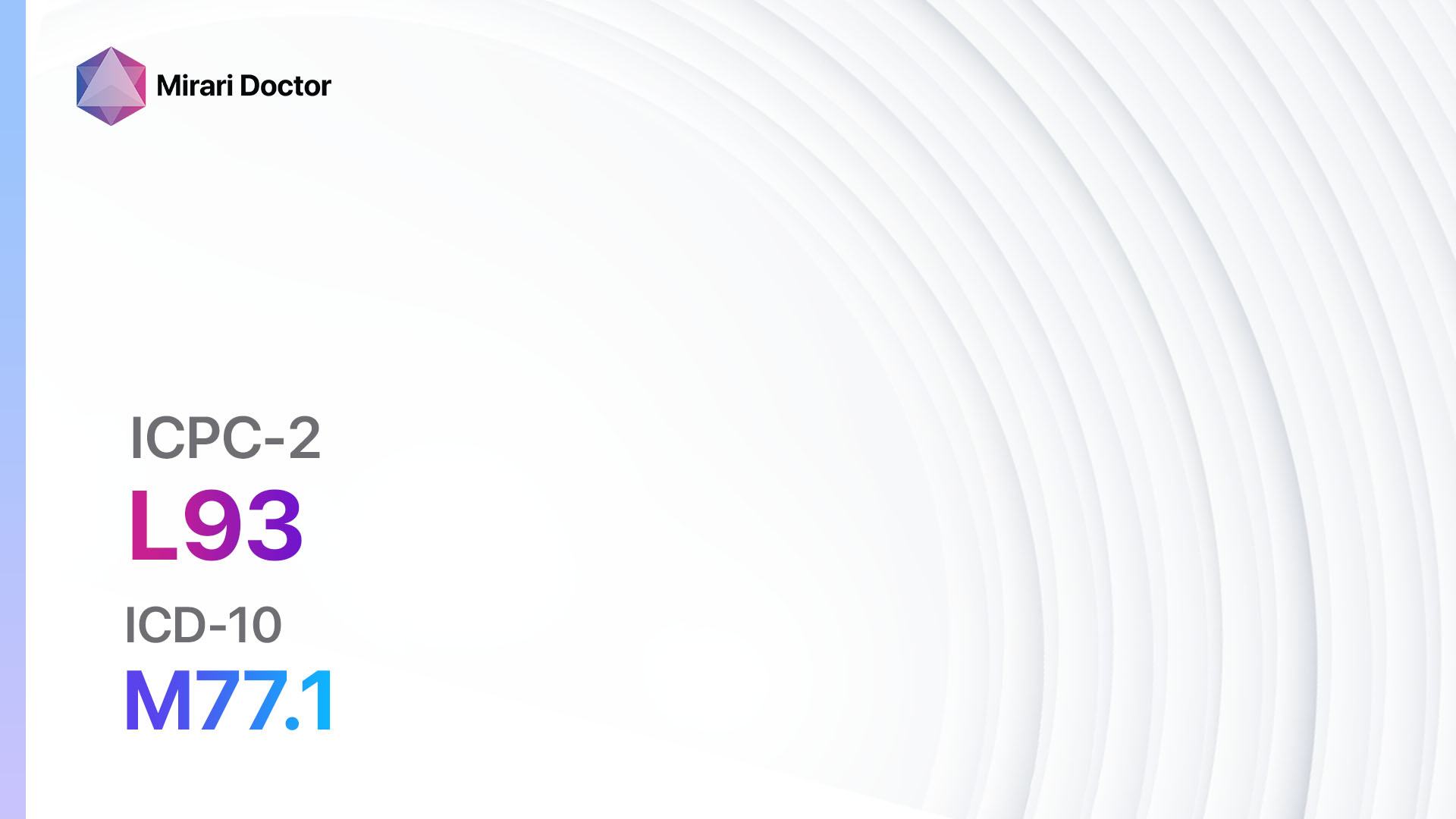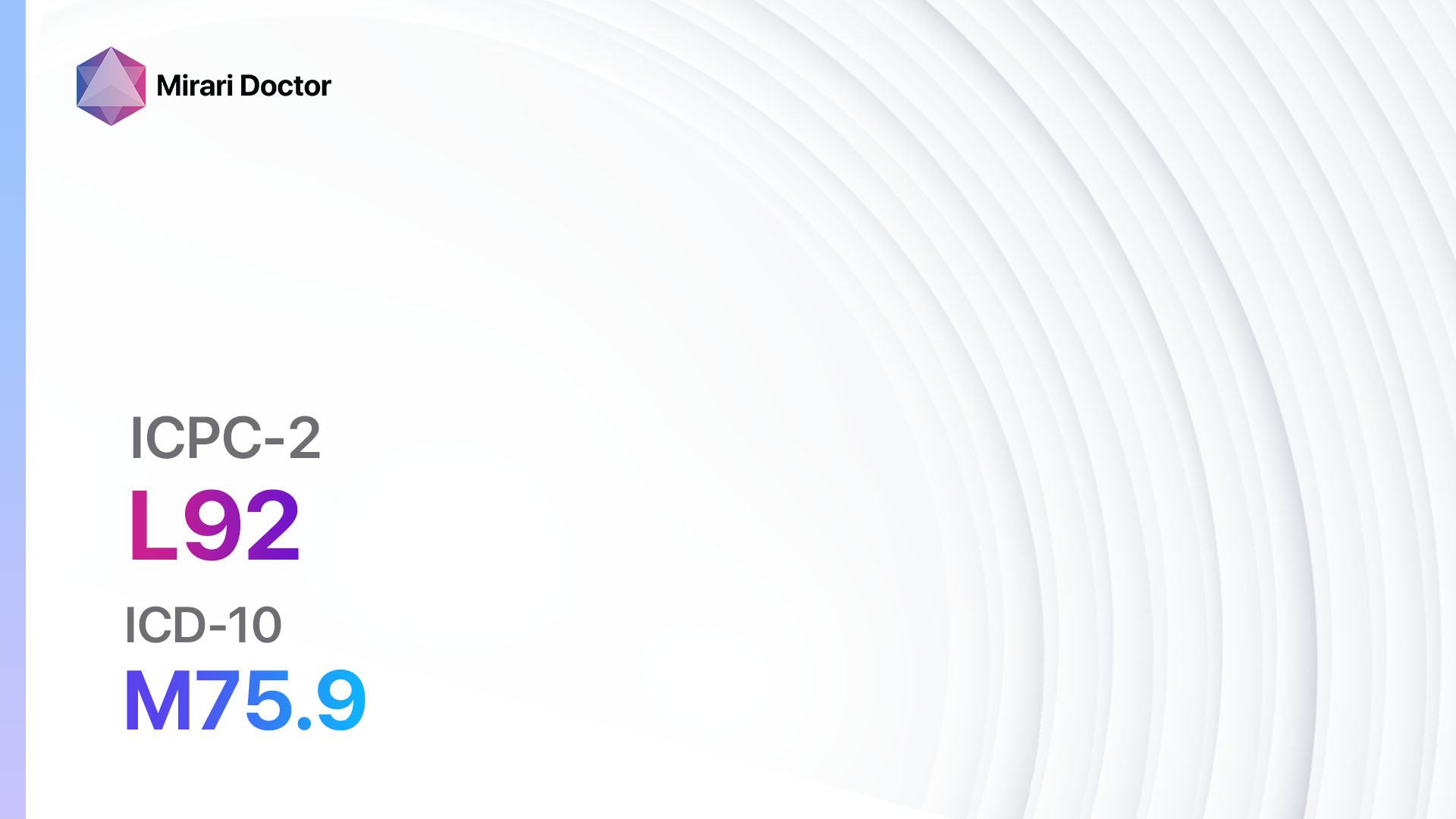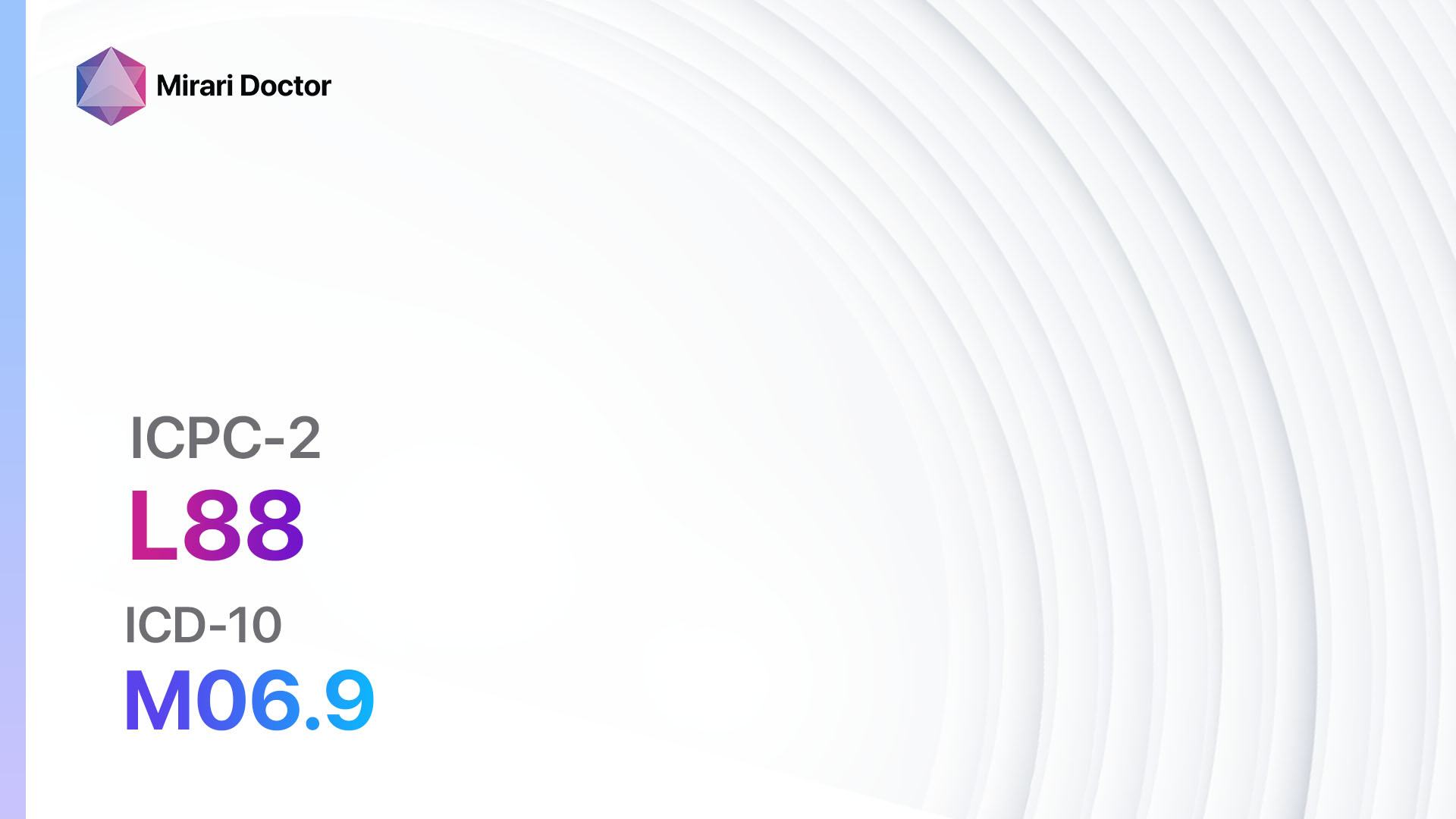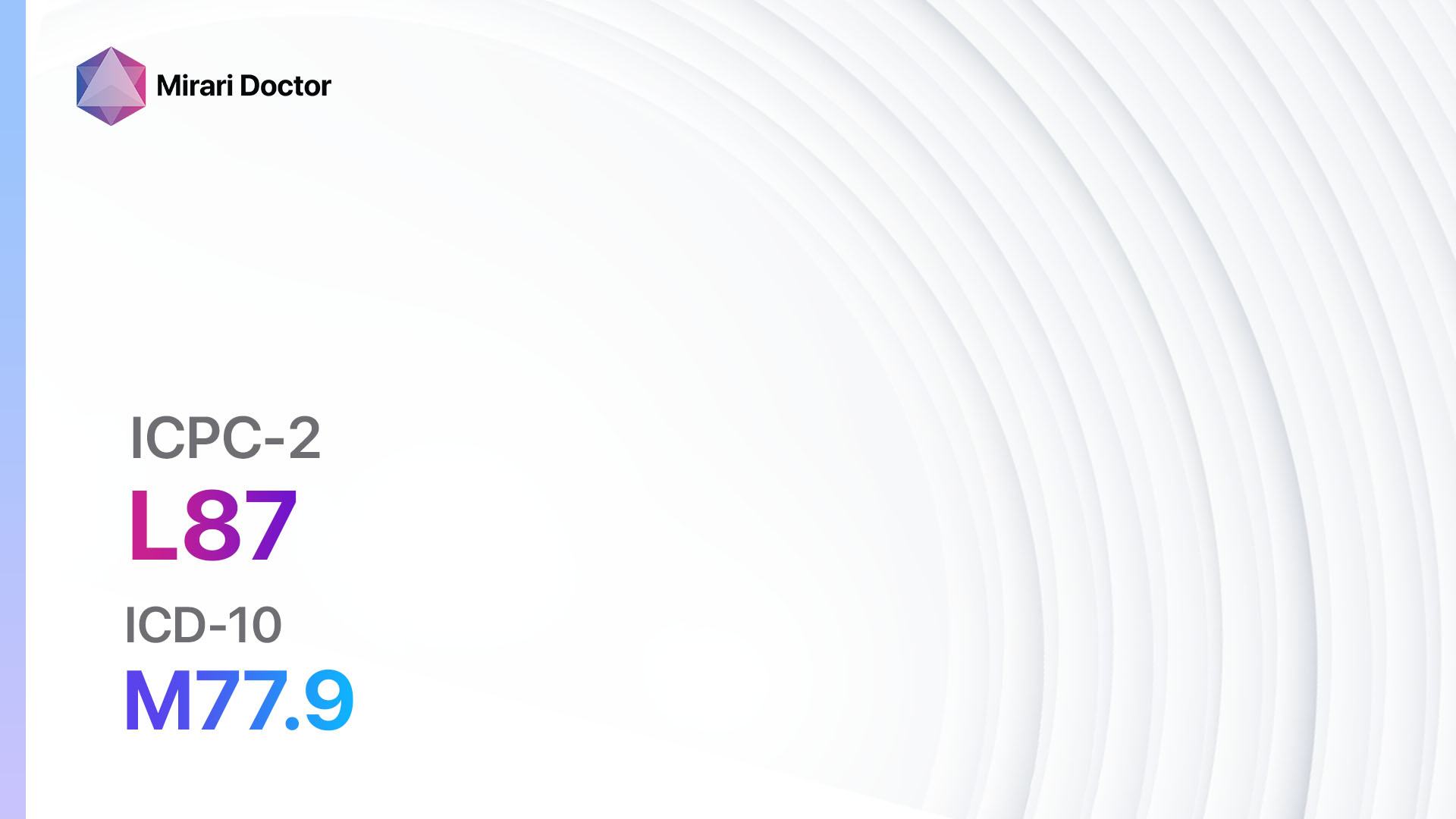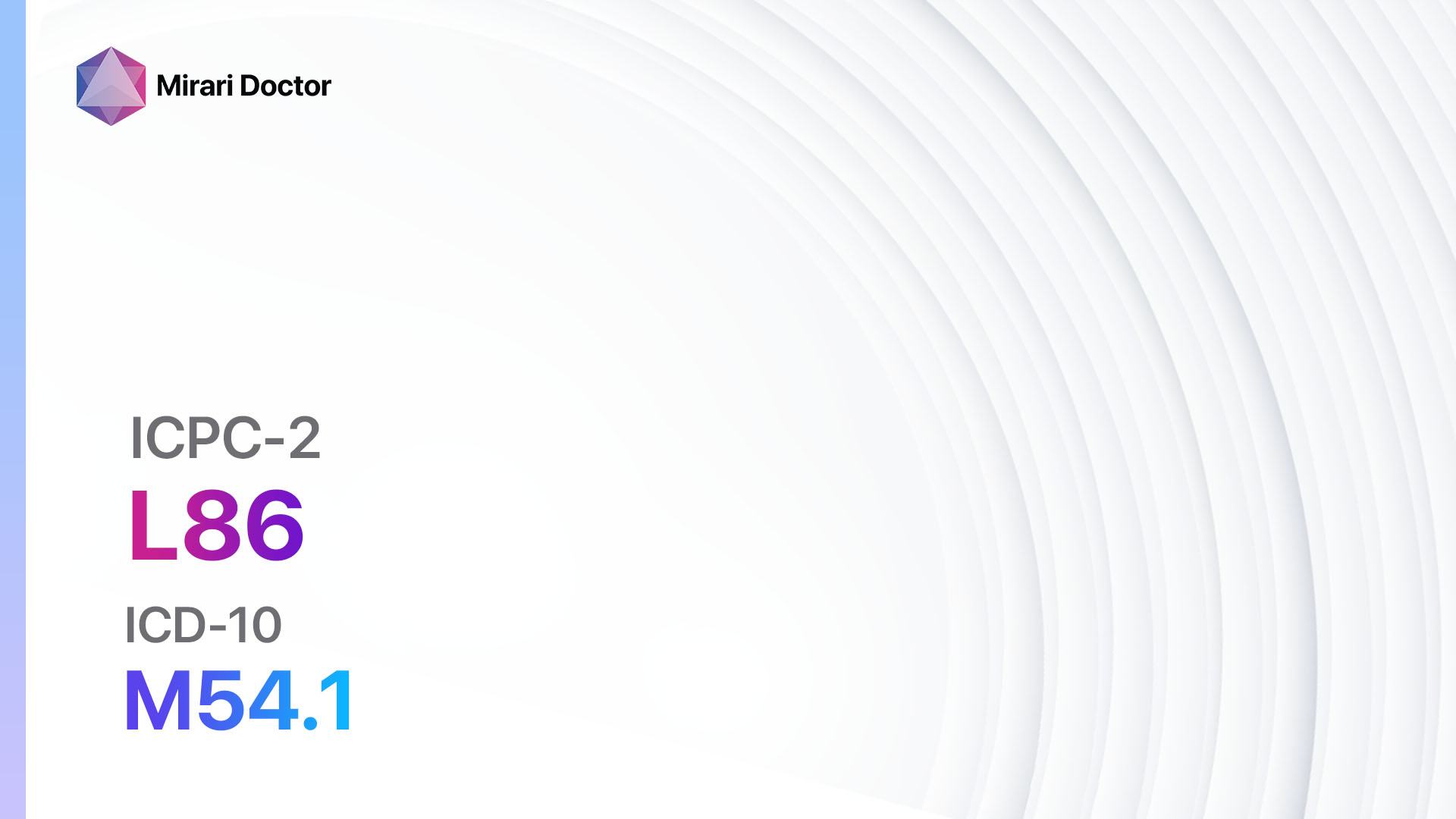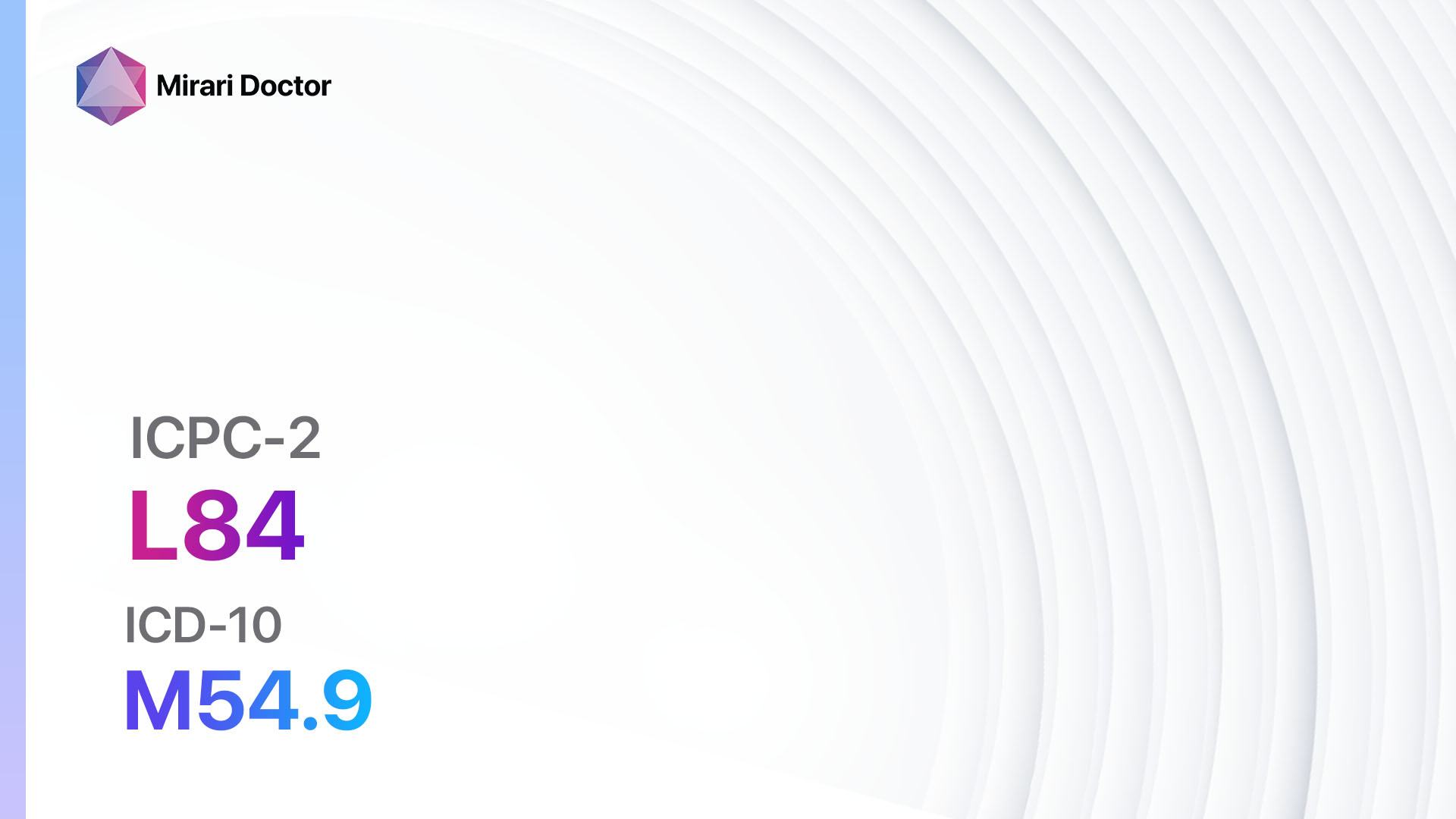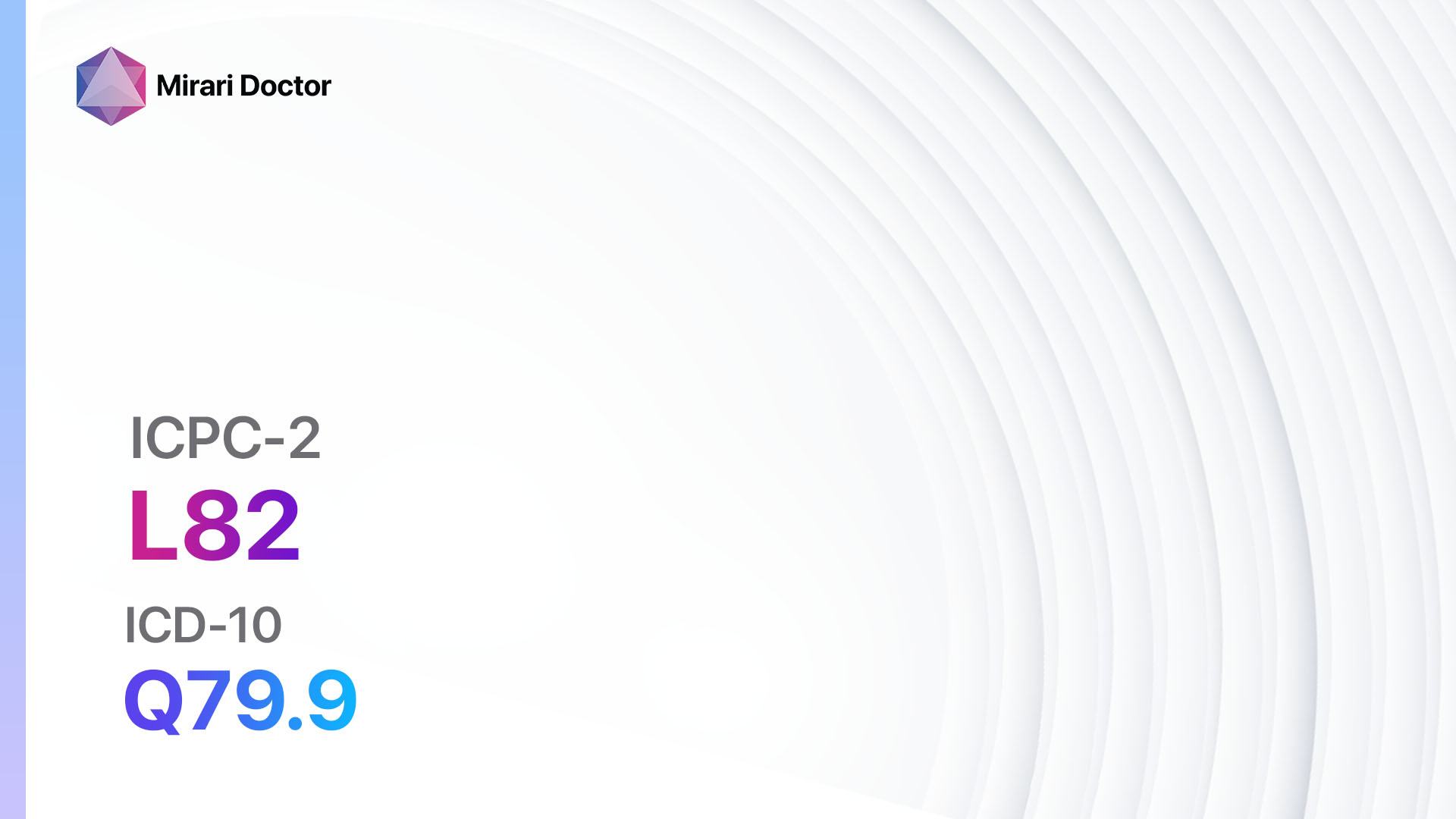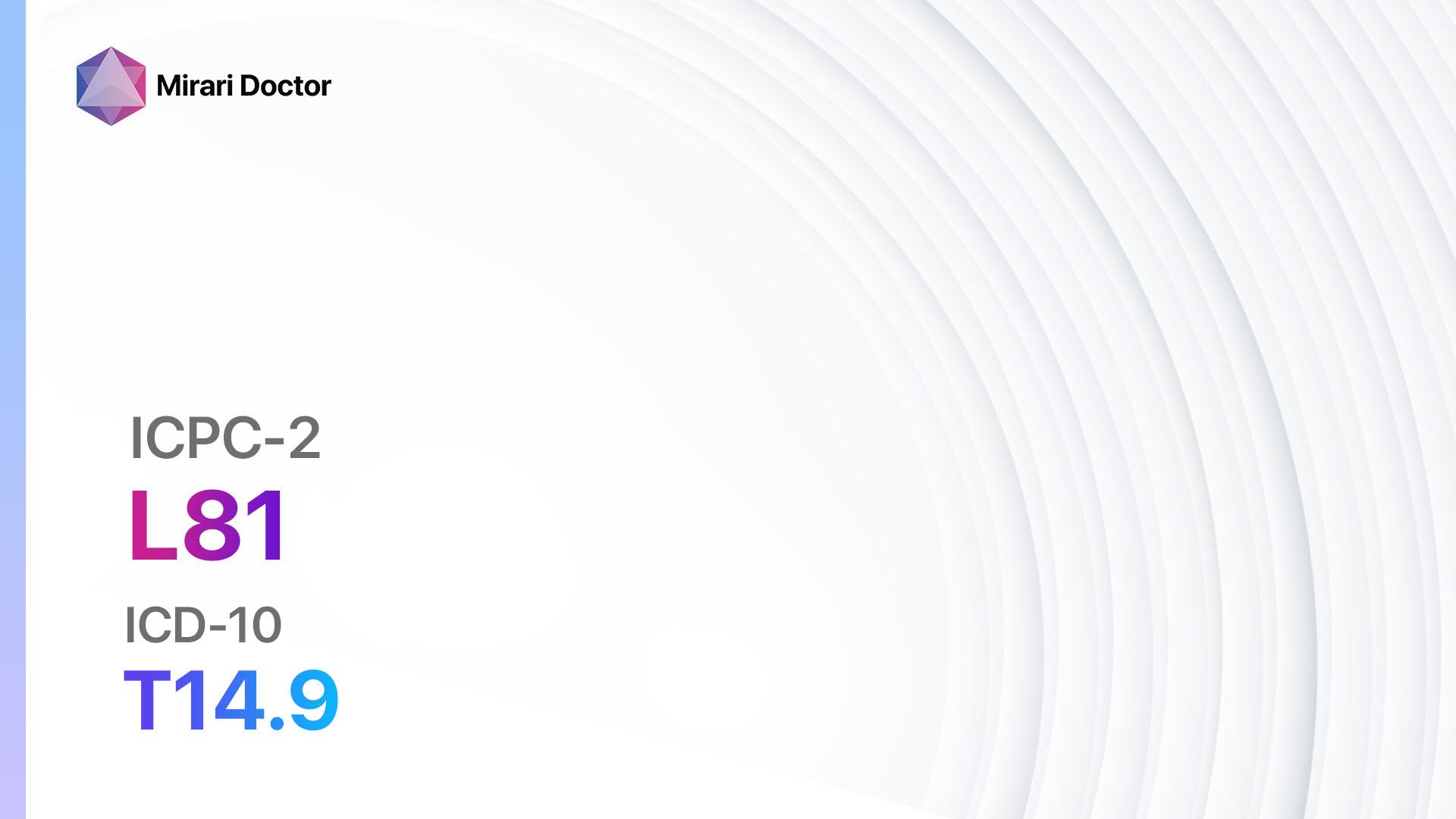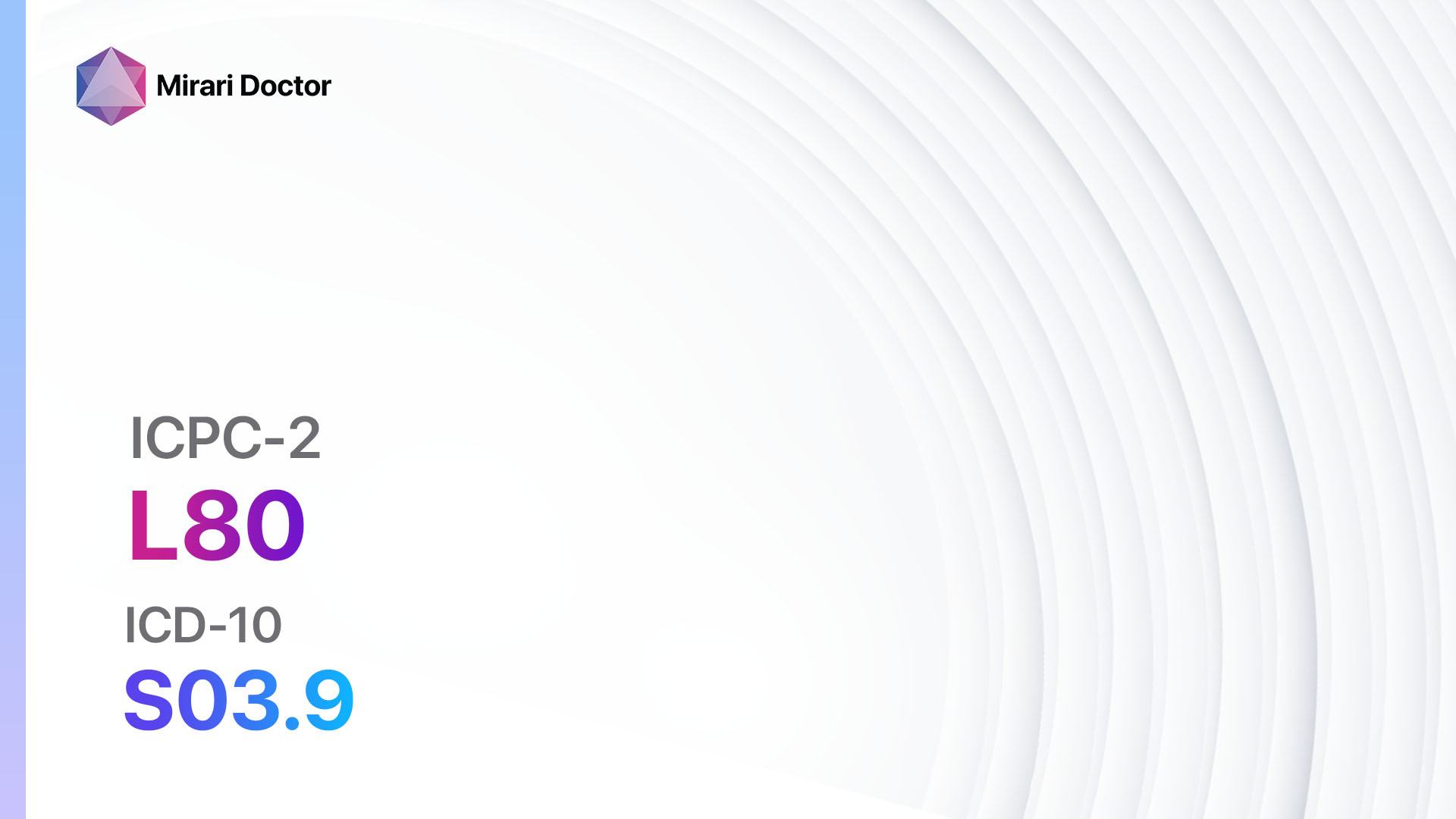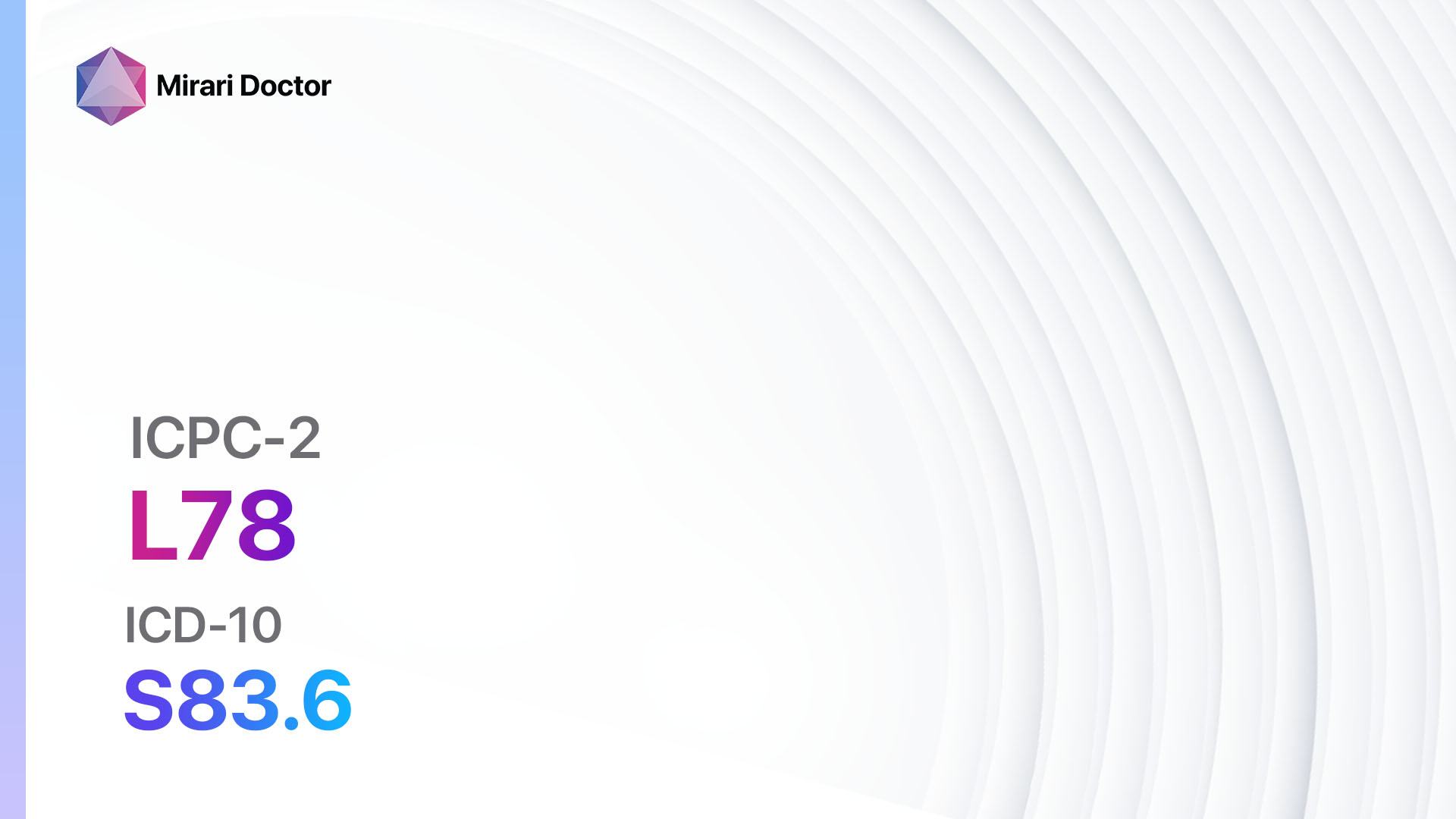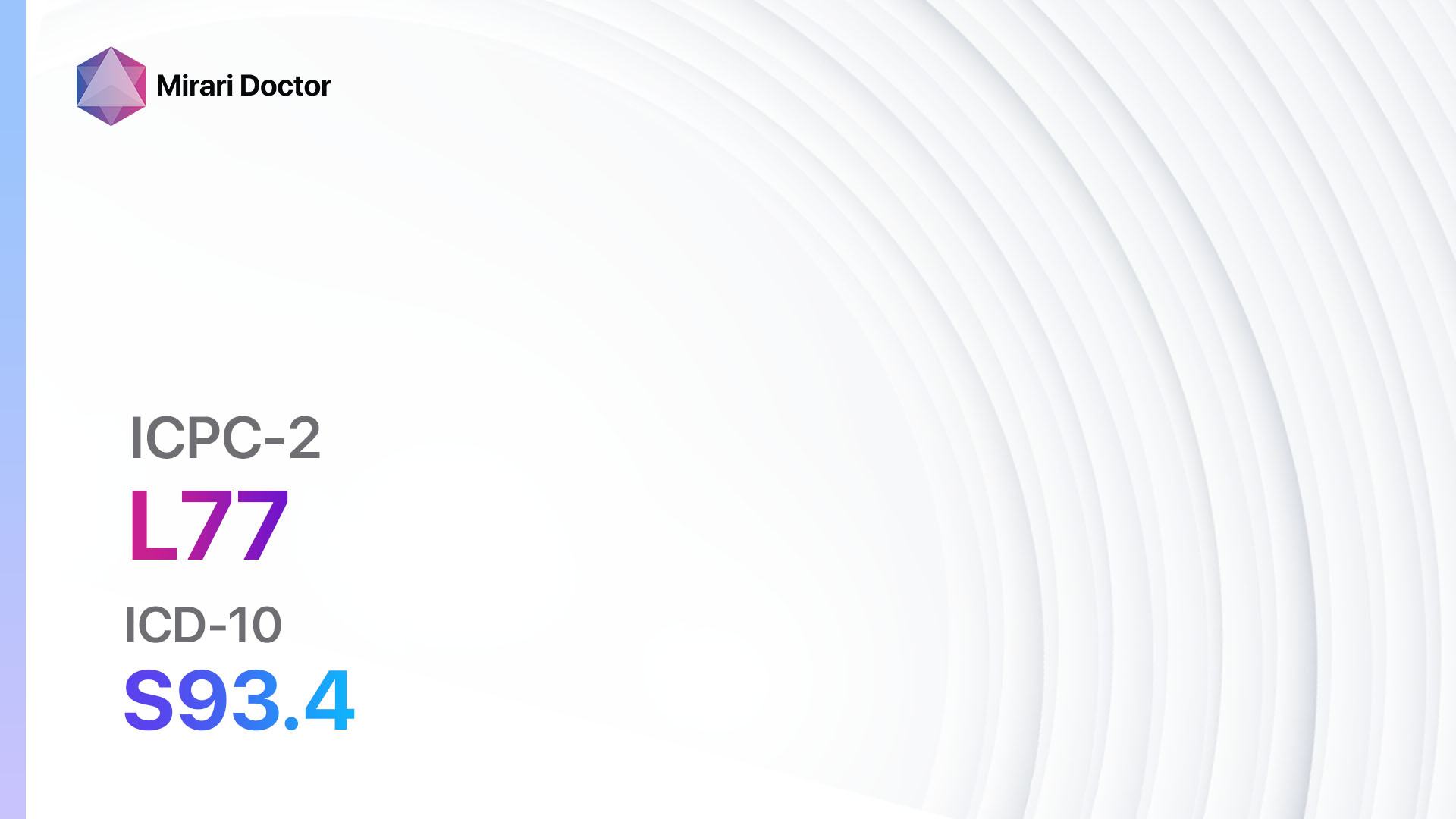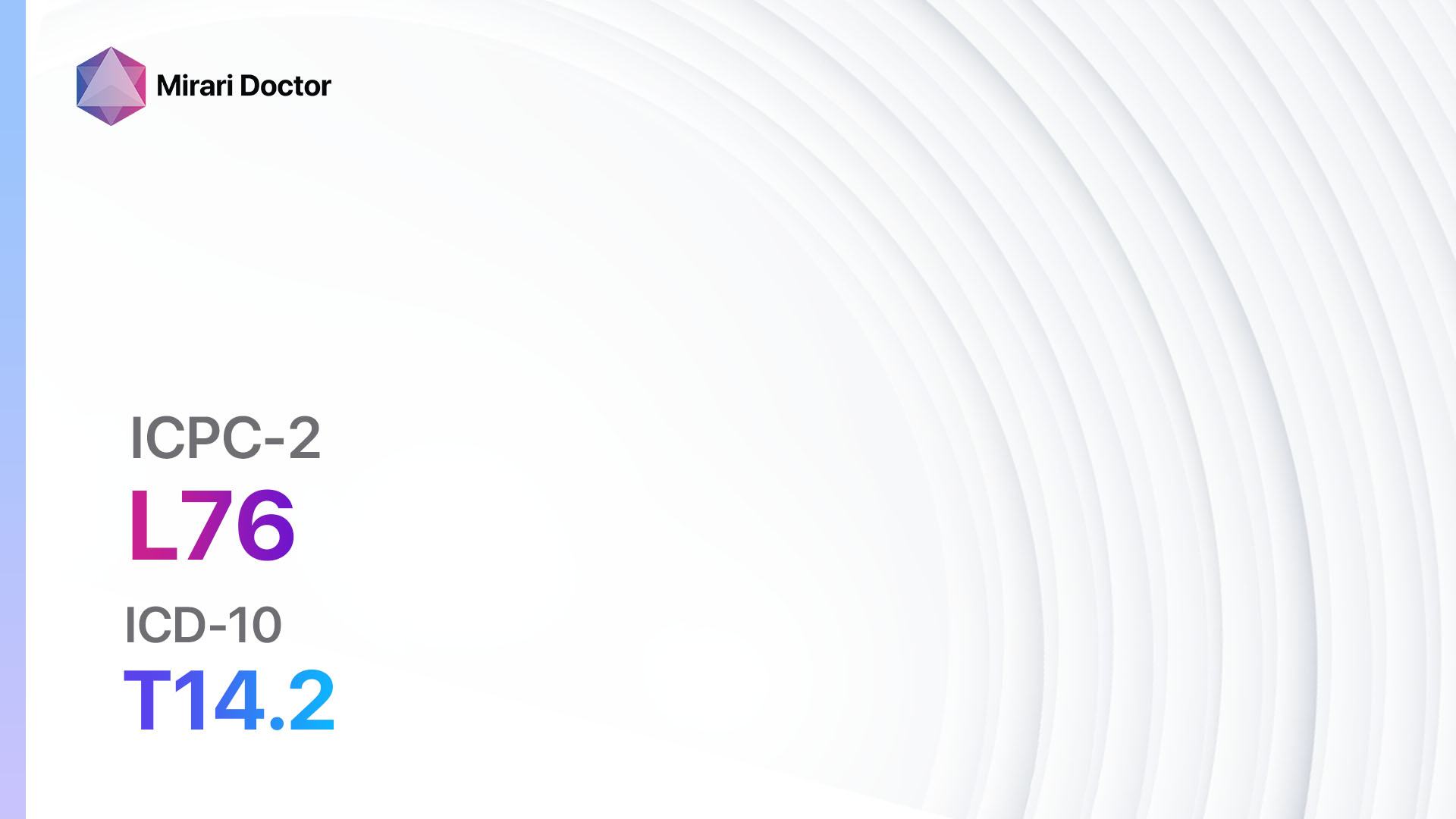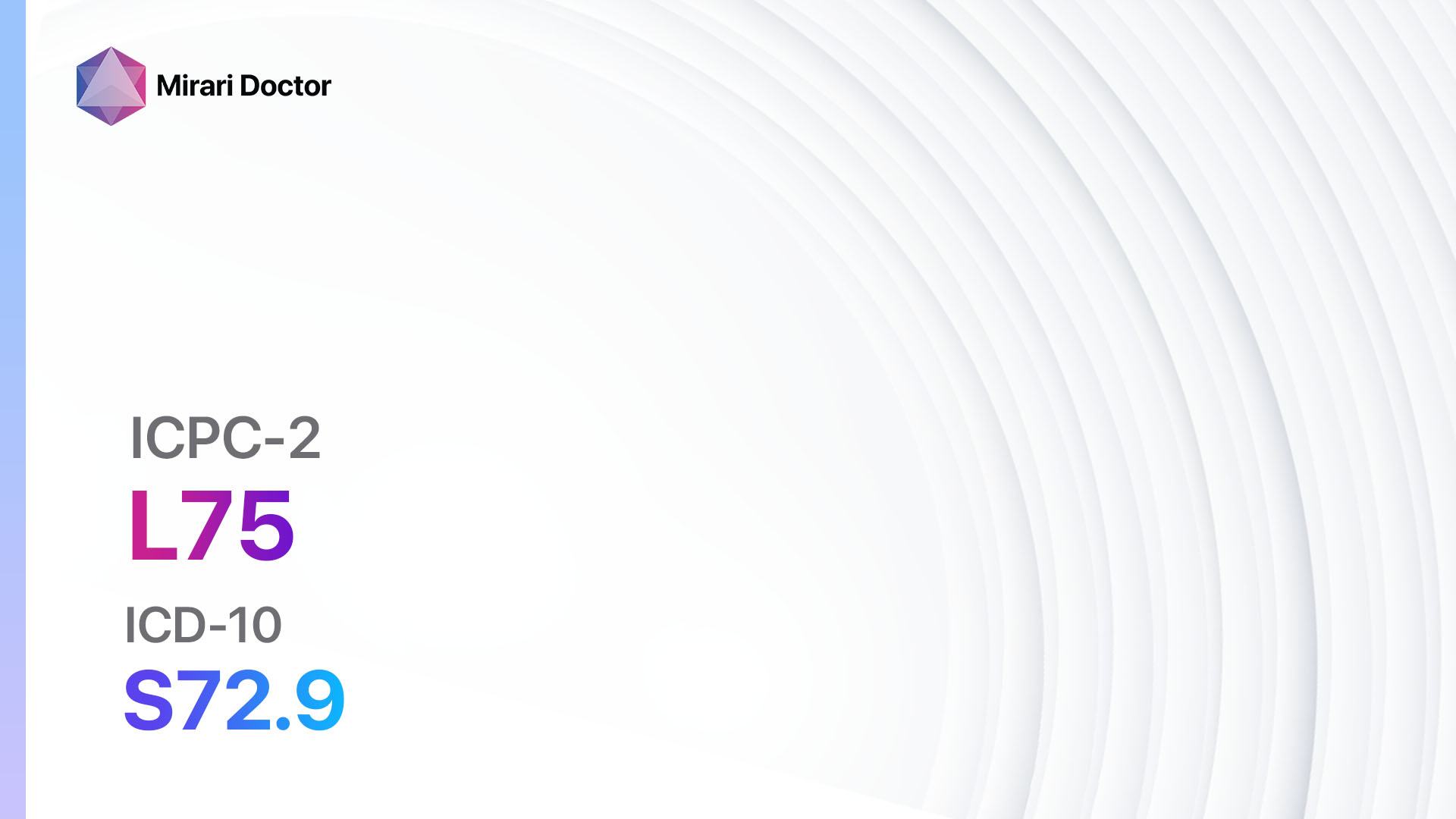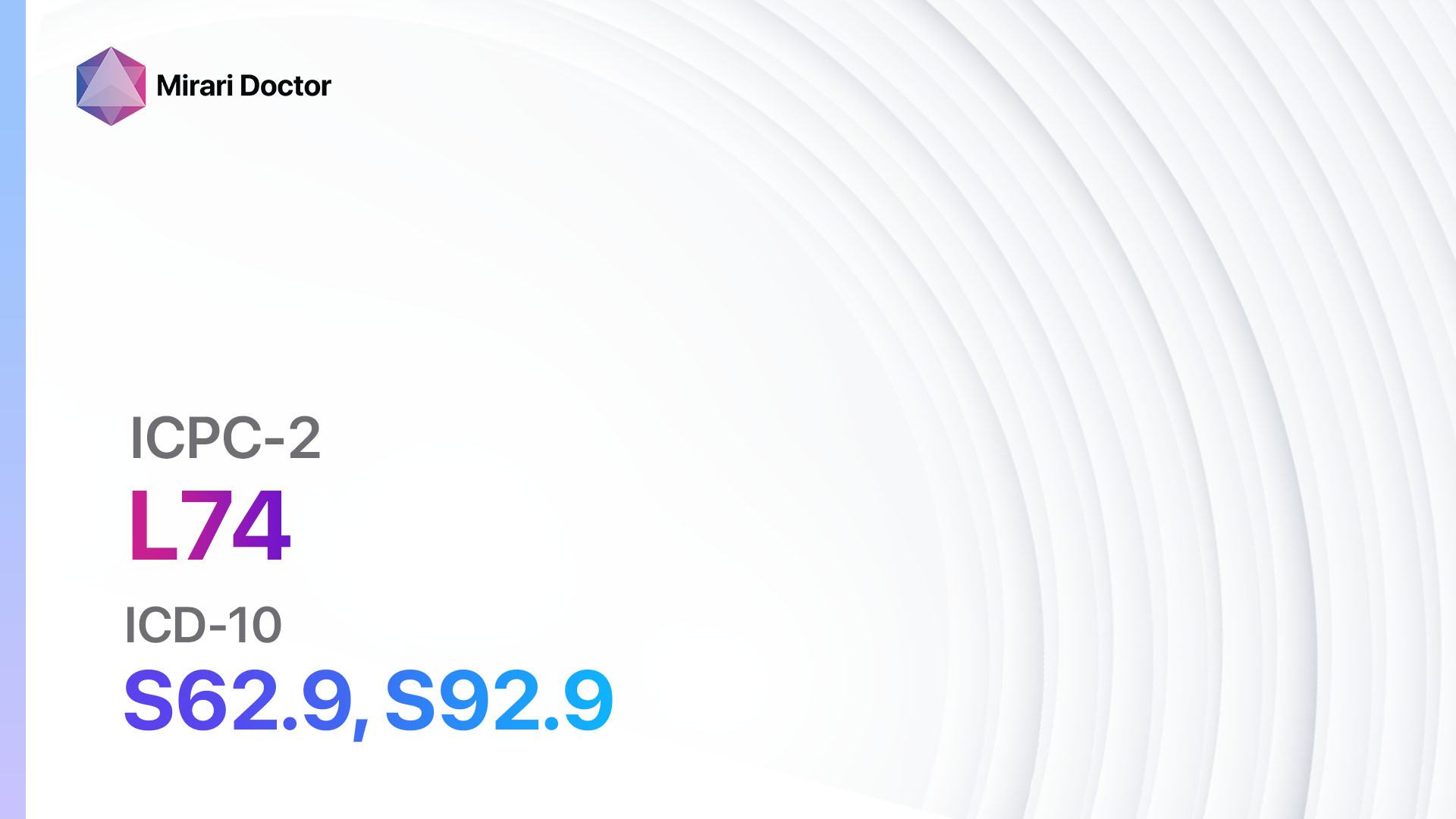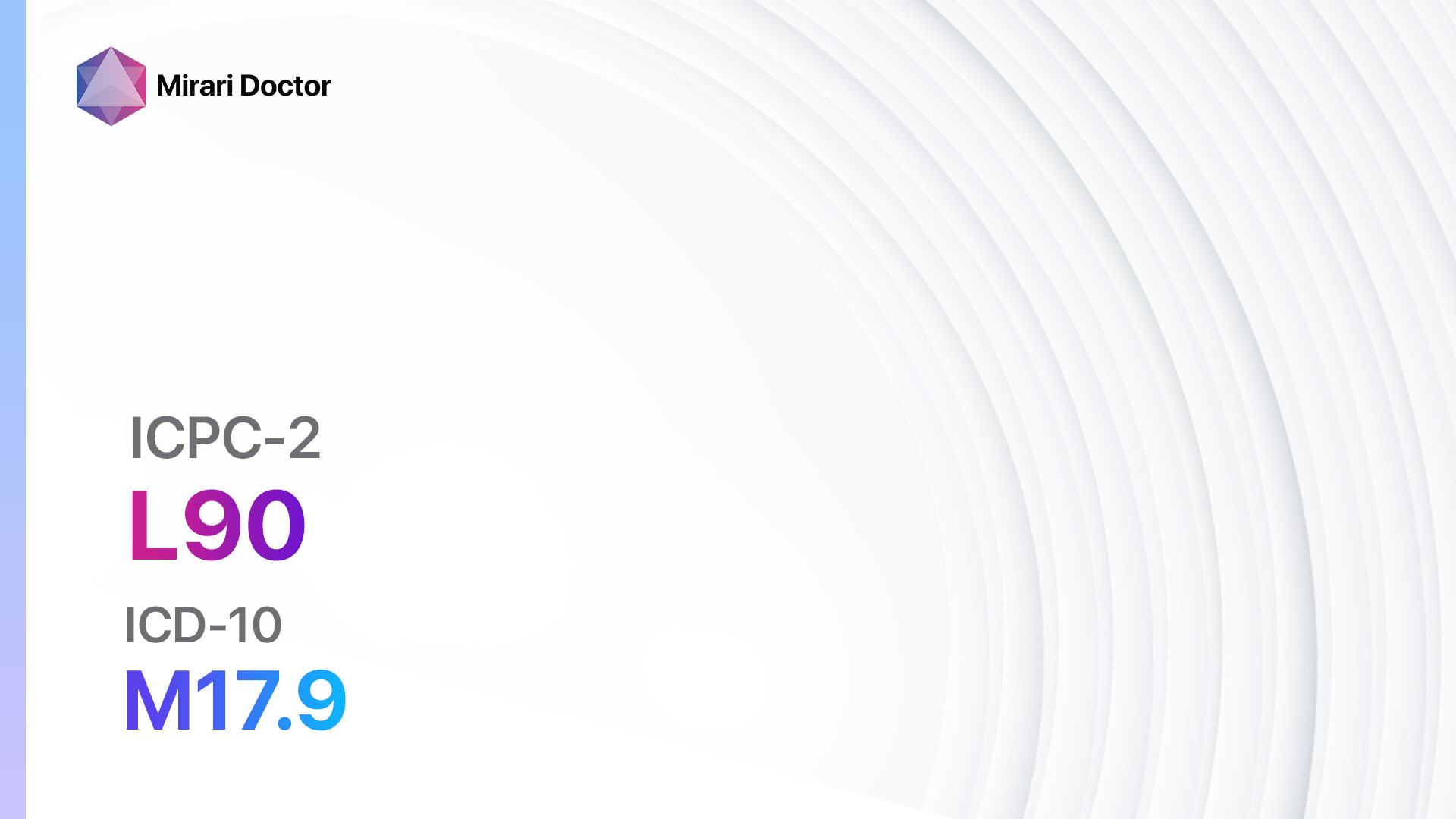
Introduction
Osteoarthrosis of the knee, also known as knee osteoarthritis, is a degenerative joint disease that primarily affects the knee joint. It is characterized by the breakdown of cartilage in the joint, leading to pain, stiffness, and reduced mobility.[1] This guide aims to provide a comprehensive overview of the diagnosis and management of osteoarthrosis of the knee.
Codes
Symptoms
- Joint pain: Patients may experience pain in the knee joint, which can range from mild to severe.[4]
- Stiffness: Stiffness in the knee joint, especially after periods of inactivity, is a common symptom.
- Swelling: Swelling and inflammation may occur in the knee joint.
- Reduced range of motion: Patients may have difficulty fully extending or flexing their knee.
- Crepitus: A grating or cracking sensation may be felt when moving the knee joint.
- Weakness: Weakness in the knee joint and surrounding muscles may be present.[5]
Causes
- Age: The risk of developing osteoarthrosis of the knee increases with age.
- Obesity: Excess weight puts additional stress on the knee joint, increasing the risk of developing osteoarthrosis.
- Joint injury: Previous knee injuries, such as ligament tears or fractures, can increase the likelihood of developing osteoarthrosis.
- Genetics: Some individuals may have a genetic predisposition to developing osteoarthrosis.
- Occupation: Jobs that involve repetitive knee movements or heavy lifting may increase the risk of developing osteoarthrosis.[6]
Diagnostic Steps
Medical History
- Gather information about the patient’s symptoms, including the duration and severity of knee pain, stiffness, and swelling.
- Assess the patient’s medical history, including any previous knee injuries or surgeries.
- Inquire about any risk factors for osteoarthrosis, such as obesity or a family history of the disease.[7]
Physical Examination
- Examine the knee joint for signs of swelling, tenderness, or deformity.
- Assess the range of motion of the knee joint and any limitations.
- Palpate the knee joint to identify areas of tenderness or crepitus.
- Evaluate the strength and stability of the knee joint.[8]
Laboratory Tests
- Blood tests: Although there are no specific blood tests for diagnosing osteoarthrosis, they may be used to rule out other conditions, such as rheumatoid arthritis or gout.[9]
Diagnostic Imaging
- X-rays: X-rays can reveal joint space narrowing, osteophyte formation (bone spurs), and other signs of osteoarthrosis.
- MRI (Magnetic Resonance Imaging): MRI may be used to assess the condition of the cartilage, ligaments, and other soft tissues in the knee joint.[10]
Other Tests
- Joint aspiration: In some cases, a sample of fluid may be withdrawn from the knee joint to rule out other causes of joint pain, such as infection or gout.
Follow-up and Patient Education
- Schedule regular follow-up appointments to monitor the progression of the disease and adjust treatment as necessary.
- Provide patient education on self-management strategies, such as weight loss, exercise, and pain management techniques.
Possible Interventions
Traditional Interventions
Medications:
Top 5 drugs for Osteoarthrosis of knee:
- Acetaminophen (e.g., Tylenol):
- Cost: $5-$15 for a month’s supply.
- Contraindications: Allergy to acetaminophen, severe liver disease.
- Side effects: Rare, but can include liver damage with high doses.
- Severe side effects: Rare, but can include severe allergic reactions.
- Drug interactions: None significant.
- Warning: Do not exceed the recommended dosage to avoid liver damage.
- Nonsteroidal anti-inflammatory drugs (NSAIDs) (e.g., Ibuprofen, Naproxen):
- Cost: $5-$20 for a month’s supply.
- Contraindications: Active peptic ulcer disease, severe kidney disease.
- Side effects: Upset stomach, heartburn, increased risk of bleeding.
- Severe side effects: Stomach ulcers, kidney damage, increased risk of heart attack or stroke.
- Drug interactions: Other NSAIDs, blood thinners.
- Warning: Long-term use of NSAIDs can increase the risk of gastrointestinal bleeding and cardiovascular events.
- Topical NSAIDs (e.g., Diclofenac gel):
- Cost: $10-$30 for a month’s supply.
- Contraindications: Allergy to NSAIDs, broken or infected skin at the application site.
- Side effects: Skin irritation, rash.
- Severe side effects: Rare, but can include severe allergic reactions.
- Drug interactions: None significant.
- Warning: Avoid applying to open wounds or mucous membranes.
- Corticosteroid injections (e.g., Triamcinolone):
- Cost: $50-$100 per injection.
- Contraindications: Active infection, bleeding disorder.
- Side effects: Temporary increase in pain, thinning of the skin.
- Severe side effects: Rare, but can include infection or damage to surrounding tissues.
- Drug interactions: None significant.
- Warning: Limit the number of injections to minimize the risk of side effects.
- Hyaluronic acid injections (e.g., Synvisc, Orthovisc):
- Cost: $500-$1000 per injection.
- Contraindications: Active infection, bleeding disorder.
- Side effects: Temporary increase in pain, swelling.
- Severe side effects: Rare, but can include infection or damage to surrounding tissues.
- Drug interactions: None significant.
- Warning: Multiple injections may be required for optimal results.
Alternative Drugs:
- Glucosamine and chondroitin: These supplements are commonly used for osteoarthrosis, although their effectiveness is still debated. Cost: $20-$50 for a month’s supply.
- Capsaicin cream: Topical cream containing capsaicin, which may help relieve pain. Cost: $10-$20 per tube.
- Duloxetine: An antidepressant that may help with chronic pain. Cost: $20-$50 for a month’s supply.
- Tramadol: A prescription pain medication that can be used for moderate to severe pain. Cost: $10-$30 for a month’s supply.
- Opioids: Reserved for severe pain that does not respond to other treatments. Cost: Varies depending on the specific medication.
Surgical Procedures:
- Total knee replacement: In severe cases where conservative treatments have failed, a total knee replacement may be recommended. Cost: $20,000-$50,000.
Alternative Interventions
- Physical therapy: Physical therapy can help improve joint mobility, strengthen muscles, and reduce pain. Cost: $50-$150 per session.
- Bracing: Knee braces or supports can provide stability and reduce pain. Cost: $50-$200 per brace.
- Weight loss: Losing weight can reduce stress on the knee joint and improve symptoms. Cost: Varies depending on the chosen weight loss method.
- Acupuncture: May help reduce pain and improve joint function. Cost: $60-$120 per session.
- Transcutaneous electrical nerve stimulation (TENS): Involves the use of low-voltage electrical currents to relieve pain. Cost: $50-$100 for a TENS unit.
- Heat and cold therapy: Applying heat or cold to the knee joint can help reduce pain and inflammation. Cost: Varies depending on the chosen method (e.g., heating pad, ice pack).
Lifestyle Interventions
- Exercise: Regular low-impact exercise, such as swimming or cycling, can help improve joint mobility and strengthen muscles. Cost: Varies depending on the chosen exercise method.
- Weight management: Maintaining a healthy weight can reduce stress on the knee joint. Cost: Varies depending on the chosen weight management method.
- Assistive devices: Using assistive devices, such as canes or walkers, can help reduce joint stress and improve mobility. Cost: Varies depending on the chosen device.
- Physical activity modification: Avoiding activities that exacerbate knee pain, such as running or jumping, can help manage symptoms. Cost: None.
- Nutritional supplements: Some supplements, such as omega-3 fatty acids or vitamin D, may have potential benefits for joint health. Cost: Varies depending on the chosen supplement.
It is important to note that the cost ranges provided are approximate and may vary depending on the location and availability of the interventions.
Mirari Cold Plasma Alternative Intervention
Understanding Mirari Cold Plasma
- Safe and Non-Invasive Treatment: Mirari Cold Plasma is a safe and non-invasive treatment option for various skin conditions. It does not require incisions, minimizing the risk of scarring, bleeding, or tissue damage.
- Efficient Extraction of Foreign Bodies: Mirari Cold Plasma facilitates the removal of foreign bodies from the skin by degrading and dissociating organic matter, allowing easier access and extraction.
- Pain Reduction and Comfort: Mirari Cold Plasma has a local analgesic effect, providing pain relief during the treatment, making it more comfortable for the patient.
- Reduced Risk of Infection: Mirari Cold Plasma has antimicrobial properties, effectively killing bacteria and reducing the risk of infection.
- Accelerated Healing and Minimal Scarring: Mirari Cold Plasma stimulates wound healing and tissue regeneration, reducing healing time and minimizing the formation of scars.
Mirari Cold Plasma Prescription
Video instructions for using Mirari Cold Plasma Device – L90 Osteoarthrosis of knee (ICD-10:M17.9)
| Mild | Moderate | Severe |
| Mode setting: 2 (Wound Healing) Location: 0 (Localized) Morning: 15 minutes, Evening: 15 minutes |
Mode setting: 2 (Wound Healing) Location: 0 (Localized) Morning: 30 minutes, Lunch: 30 minutes, Evening: 30 minutes |
Mode setting: 2 (Wound Healing) Location: 0 (Localized) Morning: 30 minutes, Lunch: 30 minutes, Evening: 30 minutes |
| Mode setting: 9 (Arthritis) Location: 0 (Localized) Morning: 15 minutes, Evening: 15 minutes |
Mode setting: 9 (Arthritis) Location: 0 (Localized) Morning: 30 minutes, Lunch: 30 minutes, Evening: 30 minutes |
Mode setting: 9 (Arthritis) Location: 0 (Localized) Morning: 30 minutes, Lunch: 30 minutes, Evening: 30 minutes |
| Mode setting: 7 (Immunotherapy) Location: 1 (Sacrum) Morning: 15 minutes, Evening: 15 minutes |
Mode setting: 7 (Immunotherapy) Location: 1 (Sacrum) Morning: 30 minutes, Lunch: 30 minutes, Evening: 30 minutes |
Mode setting: 7 (Immunotherapy) Location: 1 (Sacrum) Morning: 30 minutes, Lunch: 30 minutes, Evening: 30 minutes |
| Total Morning: 45 minutes approx. $7.50 USD, Evening: 45 minutes approx. $7.50 USD |
Total Morning: 90 minutes approx. $15 USD, Lunch: 90 minutes approx. $15 USD, Evening: 90 minutes approx. $15 USD, |
Total Morning: 90 minutes approx. $15 USD, Lunch: 90 minutes approx. $15 USD, Evening: 90 minutes approx. $15 USD, |
| Usual treatment for 7-60 days approx. $105 USD – $900 USD | Usual treatment for 6-8 weeks approx. $1,890 USD – $2,520 USD |
Usual treatment for 3-6 months approx. $4,050 USD – $8,100 USD
|
 |
|
Use the Mirari Cold Plasma device to treat Osteoarthrosis of knee effectively.
WARNING: MIRARI COLD PLASMA IS DESIGNED FOR THE HUMAN BODY WITHOUT ANY ARTIFICIAL OR THIRD PARTY PRODUCTS. USE OF OTHER PRODUCTS IN COMBINATION WITH MIRARI COLD PLASMA MAY CAUSE UNPREDICTABLE EFFECTS, HARM OR INJURY. PLEASE CONSULT A MEDICAL PROFESSIONAL BEFORE COMBINING ANY OTHER PRODUCTS WITH USE OF MIRARI.
Step 1: Cleanse the Skin
- Start by cleaning the affected area of the skin with a gentle cleanser or mild soap and water. Gently pat the area dry with a clean towel.
Step 2: Prepare the Mirari Cold Plasma device
- Ensure that the Mirari Cold Plasma device is fully charged or has fresh batteries as per the manufacturer’s instructions. Make sure the device is clean and in good working condition.
- Switch on the Mirari device using the power button or by following the specific instructions provided with the device.
- Some Mirari devices may have adjustable settings for intensity or treatment duration. Follow the manufacturer’s instructions to select the appropriate settings based on your needs and the recommended guidelines.
Step 3: Apply the Device
- Place the Mirari device in direct contact with the affected area of the skin. Gently glide or hold the device over the skin surface, ensuring even coverage of the area experiencing.
- Slowly move the Mirari device in a circular motion or follow a specific pattern as indicated in the user manual. This helps ensure thorough treatment coverage.
Step 4: Monitor and Assess:
- Keep track of your progress and evaluate the effectiveness of the Mirari device in managing your Osteoarthrosis of knee. If you have any concerns or notice any adverse reactions, consult with your health care professional.
Note
This guide is for informational purposes only and should not replace the advice of a medical professional. Always consult with your healthcare provider or a qualified medical professional for personal advice, diagnosis, or treatment. Do not solely rely on the information presented here for decisions about your health. Use of this information is at your own risk. The authors of this guide, nor any associated entities or platforms, are not responsible for any potential adverse effects or outcomes based on the content.
Mirari Cold Plasma System Disclaimer
- Purpose: The Mirari Cold Plasma System is a Class 2 medical device designed for use by trained healthcare professionals. It is registered for use in Thailand and Vietnam. It is not intended for use outside of these locations.
- Informational Use: The content and information provided with the device are for educational and informational purposes only. They are not a substitute for professional medical advice or care.
- Variable Outcomes: While the device is approved for specific uses, individual outcomes can differ. We do not assert or guarantee specific medical outcomes.
- Consultation: Prior to utilizing the device or making decisions based on its content, it is essential to consult with a Certified Mirari Tele-Therapist and your medical healthcare provider regarding specific protocols.
- Liability: By using this device, users are acknowledging and accepting all potential risks. Neither the manufacturer nor the distributor will be held accountable for any adverse reactions, injuries, or damages stemming from its use.
- Geographical Availability: This device has received approval for designated purposes by the Thai and Vietnam FDA. As of now, outside of Thailand and Vietnam, the Mirari Cold Plasma System is not available for purchase or use.
References
- Litwic A, Edwards MH, Dennison EM, Cooper C. Epidemiology and burden of osteoarthritis. Br Med Bull. 2013;105:185-199.
- World Health Organization. International Classification of Primary Care, Second edition (ICPC-2).
- World Health Organization. International Statistical Classification of Diseases and Related Health Problems 10th Revision (ICD-10).
- Zhang Y, Jordan JM. Epidemiology of osteoarthritis. Clin Geriatr Med. 2010;26(3):355-369.
- Heidari B. Knee osteoarthritis prevalence, risk factors, pathogenesis and features: Part I. Caspian J Intern Med. 2011;2(2):205-212.
- Johnson VL, Hunter DJ. The epidemiology of osteoarthritis. Best Pract Res Clin Rheumatol. 2014;28(1):5-15.
- Altman R, Asch E, Bloch D, et al. Development of criteria for the classification and reporting of osteoarthritis. Classification of osteoarthritis of the knee. Diagnostic and Therapeutic Criteria Committee of the American Rheumatism Association. Arthritis Rheum. 1986;29(8):1039-1049.
- Cibulka MT, White DM, Woehrle J, et al. Hip pain and mobility deficits–hip osteoarthritis: clinical practice guidelines linked to the international classification of functioning, disability, and health from the orthopaedic section of the American Physical Therapy Association. J Orthop Sports Phys Ther. 2009;39(4):A1-A25.
- Sinusas K. Osteoarthritis: diagnosis and treatment. Am Fam Physician. 2012;85(1):49-56.
- Guermazi A, Niu J, Hayashi D, et al. Prevalence of abnormalities in knees detected by MRI in adults without knee osteoarthritis: population based observational study (Framingham Osteoarthritis Study). BMJ. 2012;345:e5339.
Related articles
Made in USA



